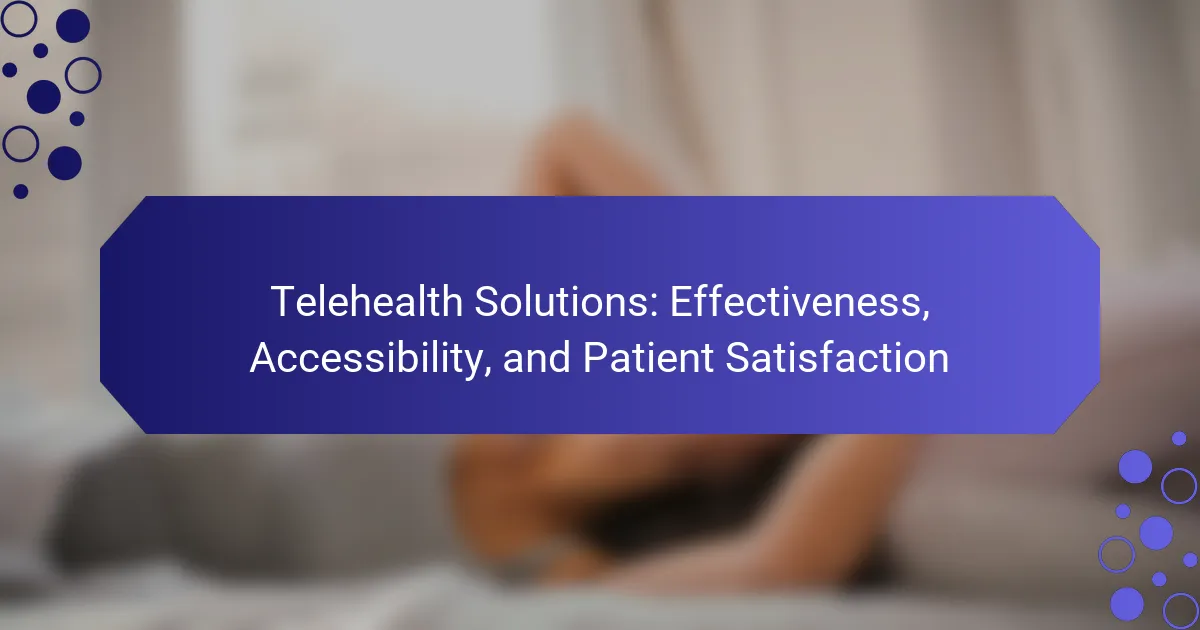Telehealth solutions significantly enhance patient care by improving accessibility, effectiveness, and satisfaction. This article explores how telehealth increases access to specialists, particularly in rural areas, and examines patient satisfaction compared to traditional visits. It also addresses barriers to accessibility, effective models for chronic disease management, and the role of technology in enhancing the telehealth experience. Finally, we discuss how patients can maximize their telehealth interactions for better outcomes.

How do telehealth solutions enhance patient care?
Telehealth solutions significantly enhance patient care by improving accessibility, effectiveness, and satisfaction. They provide remote consultations, reducing travel time and costs for patients. This convenience leads to higher engagement and adherence to treatment plans.
Telehealth has been shown to increase access to specialists, particularly in rural areas where healthcare resources are limited. A study indicated that 76% of patients reported improved access to care through telehealth services. Additionally, patient satisfaction scores often exceed those of traditional in-person visits, with many appreciating the flexibility and comfort of receiving care at home.
These solutions also support continuous monitoring of chronic conditions, allowing for timely interventions. As a result, healthcare providers can deliver personalized care more effectively. The integration of telehealth into standard practice represents a transformative shift in patient-centered care.
What are the key features of effective telehealth platforms?
Effective telehealth platforms feature user-friendly interfaces, secure data transmission, and integration with electronic health records. They also prioritize accessibility, offering mobile compatibility and support for diverse patient populations. High-quality video and audio capabilities enhance remote consultations, while real-time messaging improves communication. Patient satisfaction is boosted through easy appointment scheduling and follow-up care options.
How do telehealth solutions compare to traditional healthcare?
Telehealth solutions offer greater accessibility and convenience compared to traditional healthcare. Patients can receive care from home, reducing travel time and wait times. Studies indicate that telehealth can improve patient satisfaction, with over 80% of users reporting positive experiences. Additionally, telehealth expands access to specialists, particularly in rural areas. Traditional healthcare often involves longer appointment schedules and limited availability, which can hinder timely care. Overall, telehealth solutions demonstrate effectiveness in enhancing patient engagement and accessibility.
What role does technology play in telehealth effectiveness?
Technology significantly enhances telehealth effectiveness by improving access to care, streamlining communication, and facilitating remote monitoring. Telehealth platforms utilize video conferencing, secure messaging, and mobile health applications to connect patients with healthcare providers efficiently. This increased accessibility leads to higher patient satisfaction, as individuals can receive timely care without geographical limitations. Moreover, data analytics in telehealth can personalize treatment plans, thereby improving health outcomes. Overall, technology is pivotal in making telehealth a viable and effective healthcare solution.
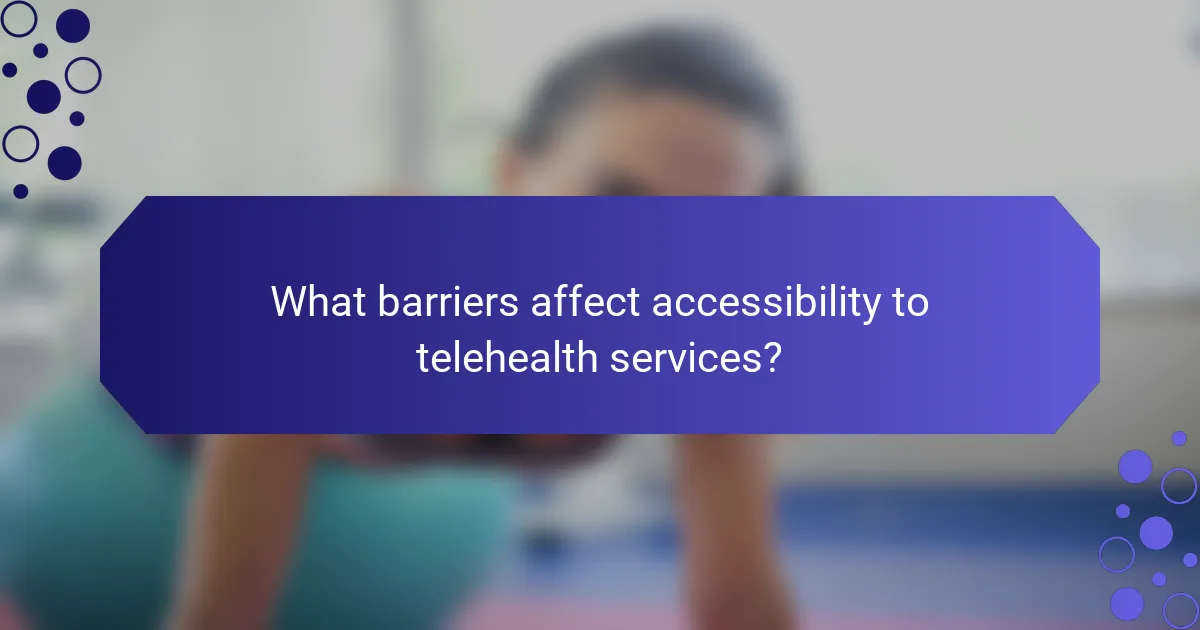
What barriers affect accessibility to telehealth services?
Barriers affecting accessibility to telehealth services include technological limitations, lack of internet access, and patient awareness. Many patients face challenges with device compatibility or insufficient digital literacy. Rural areas often experience inadequate broadband coverage, hindering service availability. Additionally, some patients may not be aware of telehealth options or how to use them effectively.
How do socioeconomic factors influence telehealth usage?
Socioeconomic factors significantly influence telehealth usage by affecting access, affordability, and technology literacy. Lower-income individuals may struggle with costs and internet access, limiting their ability to use telehealth services. Conversely, higher socioeconomic status often correlates with better access to technology and healthcare resources, enhancing telehealth adoption. Additionally, education levels impact understanding and comfort with digital health platforms, further shaping usage patterns.
What are the regional differences in telehealth accessibility?
Telehealth accessibility varies significantly by region due to factors like infrastructure, policy, and socioeconomic status. Urban areas often have better access compared to rural regions, where limited internet connectivity and fewer healthcare providers hinder telehealth use. Additionally, states with supportive telehealth regulations tend to report higher patient satisfaction and utilization rates. For example, regions that have integrated telehealth into their healthcare systems effectively see increased patient engagement and improved health outcomes.
Which populations benefit most from telehealth solutions?
Populations that benefit most from telehealth solutions include rural residents, elderly individuals, and patients with chronic conditions. These groups often face barriers to traditional healthcare access. Telehealth enhances their ability to receive timely care and follow-ups. Studies show that rural populations experience a 50% increase in healthcare access through telehealth services. Elderly patients report higher satisfaction due to reduced travel and wait times. Chronic condition management improves through regular virtual check-ins, leading to better health outcomes.
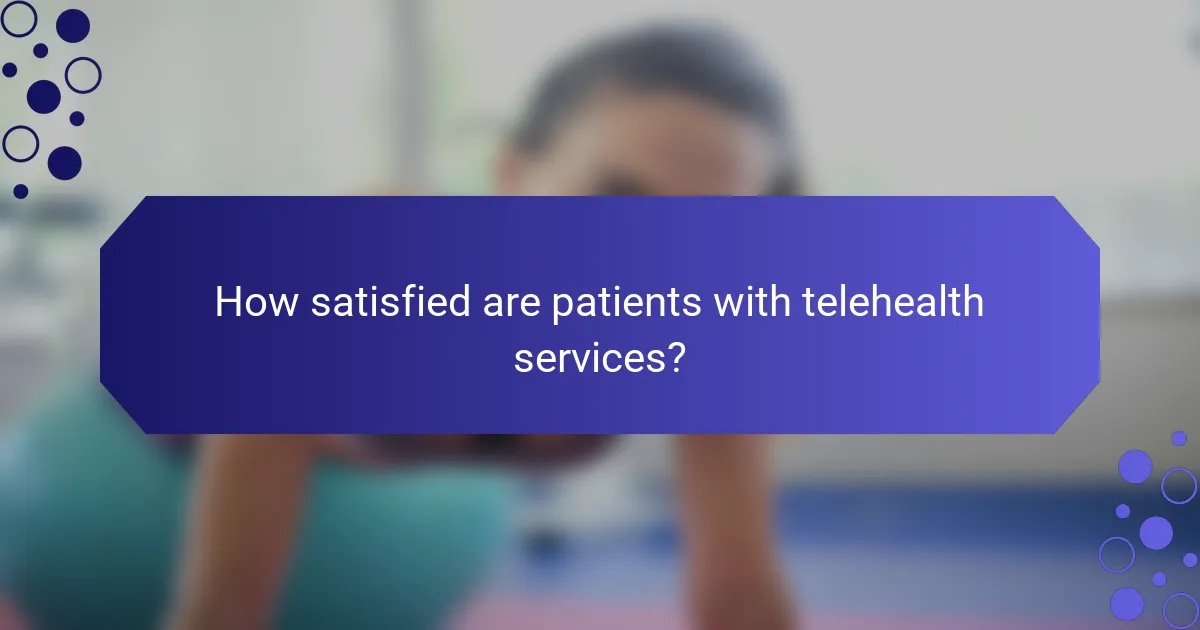
How satisfied are patients with telehealth services?
Patients generally report high satisfaction with telehealth services, citing convenience and accessibility as key factors. A study found that 80% of users felt their needs were met through telehealth. Many appreciate the reduced travel time and the ability to consult healthcare providers from home. Additionally, telehealth has improved access for patients in rural areas, enhancing overall satisfaction levels.
What metrics are used to measure patient satisfaction in telehealth?
Patient satisfaction in telehealth is measured using various metrics, including patient-reported outcomes, appointment availability, and communication quality. Key metrics often include satisfaction surveys, Net Promoter Score (NPS), and wait times. These metrics provide insights into the effectiveness and accessibility of telehealth services.
| Metric | Description |
|—————————-|—————————————————–|
| Patient Satisfaction Score | Measures overall satisfaction with telehealth visits |
| Net Promoter Score (NPS) | Assesses likelihood to recommend telehealth services |
| Appointment Availability | Evaluates ease of scheduling and accessing services |
| Communication Quality | Assesses clarity and effectiveness of provider communication |
| Follow-Up Care Satisfaction | Measures satisfaction with post-visit follow-up care |
| Wait Times | Evaluates the time patients wait for virtual appointments |
How do patient demographics impact satisfaction levels?
Patient demographics significantly influence satisfaction levels in telehealth solutions. Factors such as age, socioeconomic status, and health literacy shape patient experiences and perceptions. For instance, younger patients often report higher satisfaction due to familiarity with technology. Conversely, older adults may face challenges, impacting their overall satisfaction. Additionally, patients from lower socioeconomic backgrounds may encounter barriers to access, which can negatively affect their satisfaction levels. Understanding these demographics enables providers to tailor telehealth services effectively, enhancing patient engagement and satisfaction.
What feedback do patients provide about their telehealth experiences?
Patients generally report positive feedback about their telehealth experiences, highlighting convenience and accessibility. Many appreciate the reduced travel time and the ability to consult healthcare providers from home. A study found that over 75% of patients felt satisfied with their telehealth visits, citing effective communication as a key factor. However, some patients expressed concerns about technology issues and the lack of personal interaction. Overall, telehealth is seen as a valuable alternative to in-person visits, especially for routine consultations and follow-ups.

Which telehealth models are most effective for chronic disease management?
Telehealth models that are most effective for chronic disease management include remote patient monitoring, video consultations, and mobile health applications. These models enhance accessibility, improve patient engagement, and provide real-time health data.
Remote patient monitoring allows continuous tracking of vital signs, leading to timely interventions. Video consultations facilitate direct communication with healthcare providers, improving satisfaction and adherence to treatment plans. Mobile health applications offer resources for self-management, empowering patients to take control of their health.
Studies show that telehealth can reduce hospital readmissions by 20% and increase patient satisfaction scores significantly. As a result, these models are transforming chronic disease management through enhanced efficiency and patient-centered care.
How does remote monitoring contribute to patient outcomes?
Remote monitoring significantly enhances patient outcomes by facilitating timely interventions and personalized care. It allows healthcare providers to track vital signs and symptoms in real-time, leading to quicker adjustments in treatment plans. Studies show that patients using remote monitoring experience reduced hospital admissions and improved chronic disease management. This approach fosters greater patient engagement and satisfaction, as individuals feel more connected to their care teams. Ultimately, remote monitoring contributes to better health management and improved quality of life for patients.
What are the success rates of telehealth interventions for specific conditions?
Telehealth interventions show varied success rates depending on the specific condition treated. For chronic conditions like diabetes, studies report success rates around 80% in managing patient outcomes. Mental health interventions through telehealth demonstrate success rates of approximately 75% in improving patient satisfaction and symptom reduction. In contrast, telehealth effectiveness for acute conditions like respiratory infections is lower, with rates near 60%. Factors influencing these rates include technology access, patient engagement, and the nature of the condition being treated.
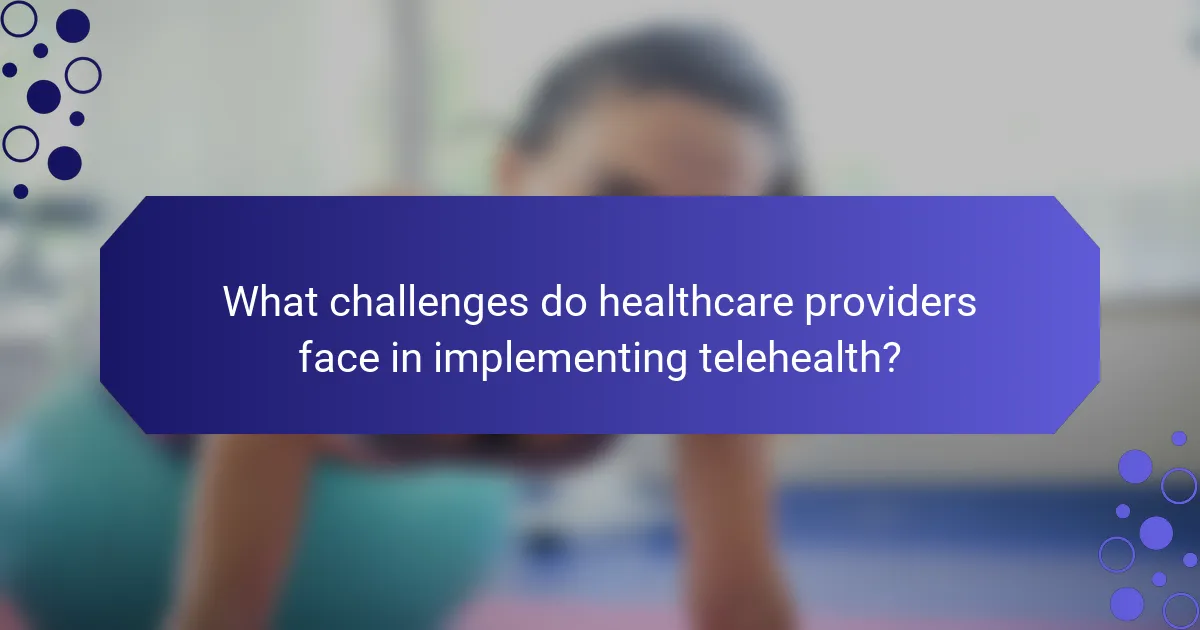
What challenges do healthcare providers face in implementing telehealth?
Healthcare providers face several challenges in implementing telehealth. Key issues include technology integration, patient privacy concerns, and varying reimbursement policies.
Technology integration can be complex, requiring staff training and reliable internet access. Patient privacy is critical, as providers must ensure compliance with regulations like HIPAA. Furthermore, inconsistent reimbursement policies across different insurers can hinder the financial viability of telehealth services.
As a result, these challenges can limit the effectiveness and accessibility of telehealth solutions, impacting overall patient satisfaction.
How do regulatory issues impact telehealth adoption?
Regulatory issues significantly hinder telehealth adoption by creating barriers to implementation. These regulations can limit reimbursement, restrict provider licensing, and complicate patient privacy compliance. As a result, healthcare providers may hesitate to adopt telehealth solutions, affecting overall accessibility and patient satisfaction. For instance, states may require specific licenses for telehealth practice, which can deter providers from offering services across state lines.
What training is necessary for healthcare providers to effectively use telehealth?
Healthcare providers require training in technology use, patient communication, and legal regulations to effectively use telehealth. This training enhances service delivery and patient engagement. It often includes hands-on practice with telehealth platforms and understanding privacy standards. Continuous education ensures providers stay updated on evolving telehealth practices.

What innovative trends are emerging in telehealth solutions?
Telehealth solutions are increasingly leveraging artificial intelligence, remote monitoring, and integrated platforms to enhance effectiveness, accessibility, and patient satisfaction. AI-driven chatbots provide immediate support, improving patient engagement. Remote monitoring tools enable continuous health tracking, leading to proactive care. Integrated platforms streamline communication between healthcare providers and patients, fostering collaboration. These trends enhance the overall telehealth experience, making healthcare more responsive and patient-centered.
How is artificial intelligence shaping the future of telehealth?
Artificial intelligence is enhancing telehealth by improving efficiency, accessibility, and patient satisfaction. AI-driven tools streamline administrative tasks, allowing healthcare providers to focus on patient care. For instance, AI chatbots assist with appointment scheduling and patient inquiries, reducing wait times. Moreover, AI analyzes patient data to offer personalized treatment recommendations, increasing the effectiveness of telehealth services. Studies show that AI integration can lead to a 30% increase in patient engagement and satisfaction. As a result, telehealth solutions become more effective and accessible, transforming the future of healthcare delivery.
What role do mobile applications play in telehealth engagement?
Mobile applications significantly enhance telehealth engagement by providing accessible communication and streamlined services. They offer features like appointment scheduling, medication reminders, and access to health records. These functionalities improve patient satisfaction and adherence to treatment plans. A study found that 70% of patients prefer using mobile apps for health management due to their convenience and efficiency. Additionally, mobile applications facilitate real-time monitoring, enabling healthcare providers to deliver timely interventions.
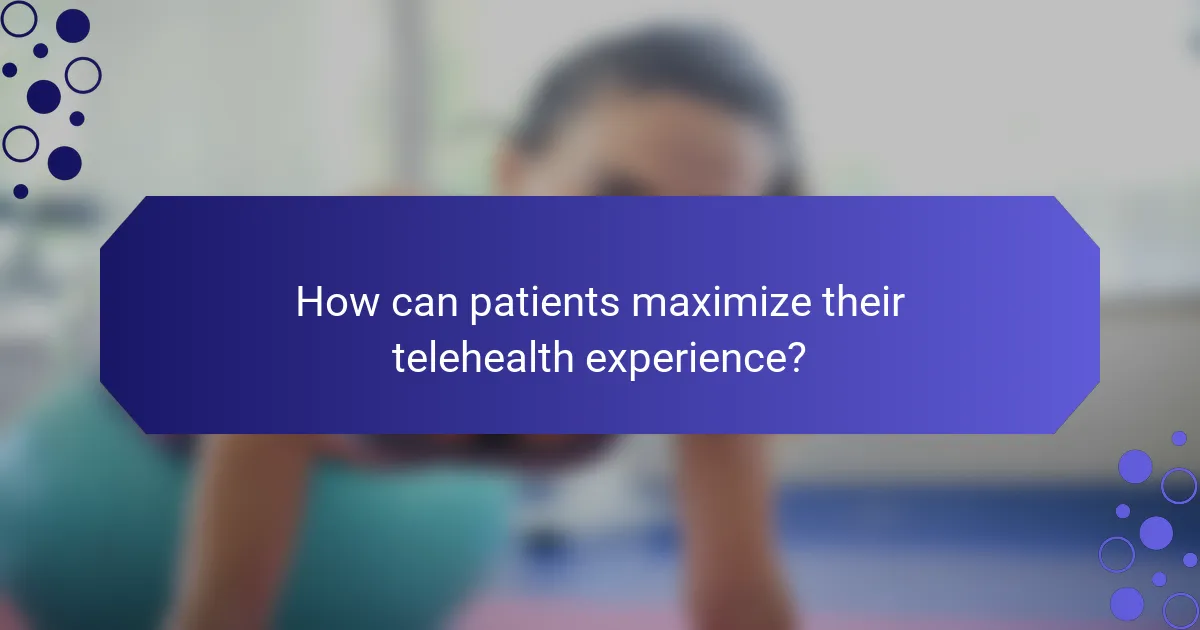
How can patients maximize their telehealth experience?
Patients can maximize their telehealth experience by preparing adequately and engaging actively. Start by ensuring a stable internet connection and a quiet environment for the appointment. Prepare a list of questions to discuss with the healthcare provider to make the most of the consultation time.
Additionally, utilize available features such as chat functions or follow-up scheduling tools to enhance communication. Familiarize yourself with the telehealth platform beforehand to navigate it confidently during the session. Engaging actively by providing clear information about symptoms and concerns can lead to better outcomes.
Lastly, providing feedback on the telehealth experience can help improve future services. Emphasizing these practices can significantly enhance patient satisfaction and effectiveness in telehealth solutions.
What best practices should patients follow for successful telehealth visits?
To ensure successful telehealth visits, patients should follow several best practices. First, prepare a list of questions or concerns before the appointment. Second, ensure a stable internet connection and a quiet environment. Third, have necessary documents or medications on hand. Fourth, log in a few minutes early to address any technical issues. Lastly, communicate clearly and openly with the healthcare provider during the visit. These practices enhance the effectiveness and patient satisfaction of telehealth solutions.
What common mistakes should patients avoid during telehealth consultations?
Patients should avoid common mistakes like technical issues, lack of preparation, and poor communication during telehealth consultations. Technical difficulties can disrupt the session, so ensure a stable internet connection and functional devices. Preparing questions in advance enhances communication with healthcare providers. Lastly, being clear and concise about symptoms is crucial for accurate diagnosis and treatment.
